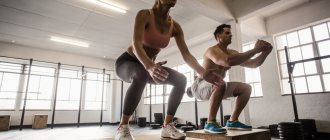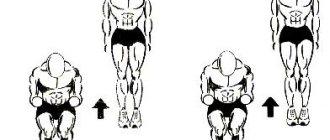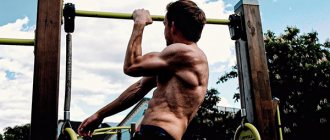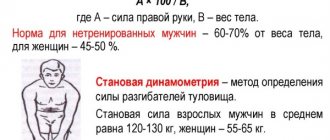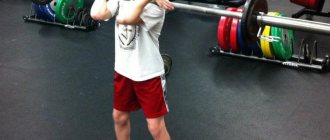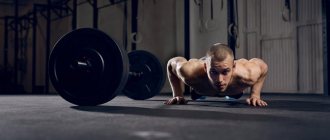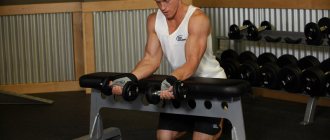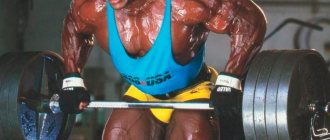Both professionals and amateurs sooner or later set themselves the goal of increasing strength indicators. If this is a team sport, then development primarily concerns jumping ability. The height and force with which a jump is made directly affects success in basketball, gymnastics, breakdancing, and volleyball.
To achieve the desired result and jump as high as possible, you can train explosive strength - the ability of muscles to push their own body weight to a certain height. Moreover, explosive power can be developed for both arms and legs. It all depends on which muscle groups are paramount in a particular sport.
AIR ALERT III
The program was developed by TMT sports based on the very popular program, Air Alert II. The program has undergone many changes. Due to the new exercise and the increase in the course (15 weeks), the creators reduced the frequency of the exercises to 3 days a week (except for the last, 15th week), but now it will have to be performed on certain days of certain weeks! After completing the full course (15 weeks), you will increase your jump by 20–35 cm. During the 4 months of completion, you should ensure yourself good sleep and nutrition.
High jump
Execution: Feet shoulder width apart. Jump straight up as far as you can. Once down, squat down to about a quarter—that’s one jump.
Note: The speed of the jump is most important when performing the exercise. The point is to jump out as quickly as possible. The time spent on the ground should be equal to fractions of a second.
Calf raises
Execution: Stand on something so that your heels do not touch the floor (stairs, thick book). Rise up on one leg as high as possible, then on the other leg.
Rest between sets: 25–30 seconds.
Step-ups
Execution: Place one foot on a strong platform (chair, bench) and push up with your supporting leg. In the air, change your supporting leg and repeat the same.
Popular programs
Air Alert (peak price: about $20)
The most popular jump increasing program was developed by Timur Tukel from North Carolina back in 1991. During this time, there were several versions of Air Alert, and the creator tried in every possible way to advertise his product through NBA players - Larry Hughes and Baron Davis were among the PR people.
Tukel believes that Davis's dunk through the future president of the RBF happened precisely because of Air Alert, but Hughes and Davis later admitted that they agreed to advertise the program solely for the money.
Boing Vert (peak price: $80)
In 2011, NBA and NFL strength coach Sean Myszka decided to compete with Air Alert and released his own program to increase his jump.
The creator assured that Boing Vert will not harm the knees, beginners will be able to see an increase in jump of 35-40 centimeters, and the program itself has been tested by the athletes with whom Myshka worked, who modestly called himself Dr. Jump.
Mad Bounce (peak price – ?)
One of the very first programs to increase the jump. So old that the official website of Mad Bounce has long been closed, but the product of the creators is still in demand in the CIS countries in recent years - most of the articles about Mad Bounce are in Russian.
All three programs can be downloaded for free today.
Are these programs effective?
Professional dunkers, a physical education instructor and ordinary fans answer.
Jumping on straight legs
Execution: Feet shoulder width apart. Make high jumps without bending your knees. You need to jump as high as possible.
Rest between sets: 1 minute.
Note: The speed of the jump is most important when performing the exercise. The point is to jump out as quickly as possible. The time spent on the ground should be equal to fractions of a second.
Burnout
Execution: The exercise is named so because when performed correctly, you will feel a burning sensation in the leg muscles. Standing in a half-squat, rise on your toes and jump in this position without falling on your heels. When performing, place the main emphasis on speed and be careful not to sink onto your heels.
Jumping in a full squat.
Full squat jumps are a new exercise. It should load the entire thigh and help increase its 'explosive strength'. It increases cardiovascular endurance, short-distance speed and lateral speed.
So, the description of the exercise:
- For balance, hold the ball in your hands (optional).
- Sit down. You should be sitting on your toes (heels raised), with your thighs parallel to the floor and your back perpendicular to the floor.
- Jump 10–15 cm. Keep the floor and hips parallel.
- After landing, push off again.
- For the last time (example: fifteenth of 15 jumps), jump as high as possible (from a sitting position up).
This exercise puts a very heavy load on the muscles and therefore needs to be performed only once a week, on Wednesdays. Increasing the frequency of the exercise will lead to the risk of overloading the muscles, increasing recovery time and reducing the jumping tone of the legs for a long time. At the end of each set, you should jump up at a maximum, explosive pace and to the highest possible height. It is very important to jump out as quickly as possible. This will force the thigh muscles to work, strengthen them and add another 3-5 cm to the jump over the entire course.
Schedule:
| A week | High jump | Calf raises | Step-ups | Jumping on toes | Burnout | Jumping in full squat |
| 1 | 2×20 | 2×10 | 2×10 | 2×15 | 1×100 | 4×15 |
| 2 | 3×20 | 2×15 | 2×15 | 2×20 | 1×200 | 4×20 |
| 3 | 3×25 | 2×20 | 2×15 | 2×25 | 1×300 | 4×20 |
| 4 | 3×30 | 2×25 | 2×20 | 2×30 | 2×200 | 4×20 |
| 5 | 4×25 | 2×30 | 2×20 | 2×35 | 2×250 | 4×25 |
| 6 | 2×50 | 2×35 | 2×25 | 2×40 | 2×300 | 4×30 |
| 7 | 4×30 | 2×40 | 2×25 | 2×50 | 2×350 | 5×25 |
| 8 | 3×50 | 2×45 | 2×30 | 2×60 | 4×200 | 5×25 |
| 9 | 4×50 | 2×50 | 2×30 | 2×70 | 3×300 | 5×30 |
| 10 | 5×40 | 2×55 | 2×35 | 2×80 | 4×250 | 5×30 |
| 11 | 6×50 | 4×30 | 2×35 | 2×90 | 4×275 | 5×30 |
| 12 | 4×75 | 4×35 | 2×40 | 2×100 | 4×300 | 6×30 |
| 13 | The program is not running! | |||||
| 14* | 3×30 | 2×30 | 2×20 | 2×30 | 1×250 | 4×20 |
| 15** | 4×100 | 4×50 | 2×50 | 2×100 | 4×400 | 5×50 |
Air Alert III must be performed 3 days a week and preferably at the same time. The program takes 15 weeks in total.
2x25 means doing two sets of 25 reps.
In the third version of the program, rest between approaches should not exceed 2 minutes, and there SHOULD NOT be a break between exercises! During the pause between approaches, massage the muscle groups that received the load.
It is best to perform the program at 13-15 hours of the day (peak muscle work).
The 13th week requires complete rest. The program execution must be stopped!
14* - this week is done to prepare for the last week. Therefore, the number of executions is reduced.
15** - Week 15 exercises are performed on Monday, Tuesday, Thursday and Friday. The last week puts maximum stress on the muscles before final recovery. Therefore, the number of repetitions has been increased and classes are held for 4 days. Jumping ability will reach its maximum level 4-7 days after the end of the program.
Important! Air ALERT III has its own specific execution schedule!
On even weeks (2,4...) the program runs on Tuesdays, Wednesdays and Thursdays.
On odd-numbered weeks, perform the program on Mondays, Wednesdays and Fridays.
On days when you don't need to do AA3, you should still give your legs the usual jumping load. This is best done during games. Come out and play! But try to do all the jumps as aggressively as possible. This will strengthen muscle memory.
If you wish, you can take the program again, but:
- the break between executions must be at least a month;
- doing it again will not give as good results as the first time.
What factors are decisive?
To increase your jumping height, it is important not only to train, but also to have appropriate physical training and adhere to a healthy lifestyle. Those who have seriously decided to achieve good jumping ability must:
- visit the gym regularly;
- create all the conditions for the full strengthening and restoration of muscles, getting enough sleep and eating right;
- record the results achieved once a month.
The main thing is to start training prepared. First, do a warm-up for about 10-20 minutes, then stretch. If you neglect to warm up, there is a high risk of injury.
If you follow all the recommendations, exercise 3-4 times weekly, without missing training, then literally in a month your jumps will be significantly higher than before starting classes.
Igor May 19, 2016
Air Alert
High jump
Feet shoulder width apart. Jump straight up as far as you can. Once down, squat down to about a quarter—that’s one jump.
Note: The speed of the jump is most important when performing the exercise. The point is to jump out as quickly as possible. The time spent on the ground should be equal to fractions of a second.
Calf raises
Stand on something so that your heels do not touch the floor (stairs, thick book). Rise up on one leg as high as possible, then on the other leg.
Step-ups
Place one foot on a strong platform (chair, bench) and push up with your supporting leg. In the air, change your supporting leg and repeat the same.
Half squat jumps
Stand with your feet shoulder-width apart and bring your knees together. Now jump in this pose using only your calves (without extending your legs).
Note #1: Jump speed is most important when performing the exercise. The point is to jump out as quickly as possible. The time spent on the ground should be equal to fractions of a second.
Note #2: Another variation of this exercise is jumping with straight legs. One way or another, the main task is to jump using only the calf muscles. In this situation, as a rule, it is very difficult to lift yourself off the ground by more than 10–15 centimeters.
Burnout
The exercise is named this way because when performed correctly, you will feel a burning sensation in your leg muscles. Standing again in a half-squat, rise on your toes and jump in this position without falling on your heels. When performing, place the main emphasis on speed and be careful not to sink onto your heels.
Execution order:
- Warm-up (jumping rope, running in place)
- Stretching
- High jump
- Calf raises
- Step-ups
- Half squat jumps
- Burnout
- Relaxation (stretching)
Air Alert must be performed 5 days a week. The program takes 12 weeks in total.
Legend: 2x25 means you need to do two sets of 25 repetitions.
| A week | High jump | Calf raises | Step-ups | Half squat jumps | Burnout |
| 1 | 2×25 | 2×10 | 2x10 | 2×15 | 1×100 |
| 2 | 1×50 | 2×20 | 2×15 | 2×20 | 1×200 |
| 3 | 1×75 | 2×25 | 2×15 | 2×25 | 1×300 |
| 4 | 1×75 | 2×30 | 2×20 | 2×30 | 1×400 |
| 5 | 2×50 | 2×35 | 2×20 | 2×35 | 1×500 |
| 6 | 1×100 | 2×40 | 2×25 | 2×40 | 1×600 |
| 7 | 1×125 | 2×45 | 2×25 | 2×50 | 1×700 |
| 8 | 2×75 | 2×50 | 2×30 | 2×60 | 1×800 |
| 9 | 2×100 | 2×55 | 2×30 | 2×70 | 1×900 |
| 10 | 2×125 | 2×60 | 2×35 | 2×80 | 1×1000 |
| 11 | 2×150 | 2×65 | 2×35 | 2×90 | 1×1100 |
| 12 | 2×200 | 2×70 | 2×40 | 2×100 | 1×1200 |
Jumping characteristics
Basic terms
Jumping ability is the body’s ability to achieve maximum concentration of muscular and volitional efforts in a minimum period of time when covering vertical and horizontal distances.
Explosive strength is the ability to exert large amounts of force in the shortest amount of time.
In volleyball, basketball, and handball, explosive power is realized in jumps, fast breaks, and powerful long passes.
Types of jumping ability
- General jumping ability. Ability to jump high or long.
- Special jumping ability. The ability to develop high repulsion speed while jumping.
A quick take-off initially sets a high take-off speed. And the higher the speed, the higher the athlete can jump.
Factors influencing the development of jumping ability
Level of muscle coordination. It is characterized by coordinated work, sequential inclusion in the process, and the ratio of optimal tension values of groups or individual muscles involved in the jump.
High lability of nerve centers. Allows the athlete to concentrate efforts in a minimum amount of time to perform a high-quality jump.
Neuropsychic and emotional state. A stable psyche, the ability to concentrate on the task at hand and make volitional efforts in critical situations are the key to high results in sports.
Individual characteristics of the athlete’s joint-ligamentous and muscular systems. Extensibility, elasticity, elasticity of muscle fibers, rate of increase in tension, all these parameters will affect the athlete’s jumping ability.
The degree of manifestation of physical qualities. To increase explosive strength, develop and improve jumping ability, it is necessary to work on both general physical indicators and endurance.
AIR ALERT II
The program was developed by TMT sports. This is one of the most popular programs for increasing jumps today. The program requires a serious approach and attitude to the exercises. After completing the full course (12 weeks), you will increase your jump by 20–30 cm. During 3 months of completion, you should ensure yourself good sleep and nutrition. Execution order:
Warming up
Jumping rope, running in place for 3-5 minutes.
Stretching
Before performing it, it is necessary to stretch all muscle groups that are involved in the program. The calves are stretched with exercises similar to step-ups (put your foot on a book or ladder and try to reach your heel to the floor). To stretch the anterior thigh muscle, place your foot on a chair or table and tilt your body toward that leg. The popliteus muscle is stretched by simple bending.
High jump
Feet shoulder width apart. Jump straight up as far as you can. Once down, squat down to about a quarter—that’s one jump.
Note: The speed of the jump is most important when performing the exercise. The point is to jump out as quickly as possible. The time spent on the ground should be equal to fractions of a second. Note: You should feel your anterior thigh muscles tightening more than your calves. Rest between sets: 3–4 minutes
Calf raises
Stand on something so that your heels do not touch the floor (stairs, thick book ~10cm). Lift up on one leg as high as possible using only your calves, then on the other leg. Rest between sets: 25 seconds.
Step-ups
Place one foot on a strong platform (chair, bench) and push up with your supporting leg. In the air, change your supporting leg and repeat the same. Rest between sets: 3–4 minutes
Jumping on toes
Stand on both feet and push up as hard as possible using only your calves. The point of the exercise is to jump as high as possible and “stay on the ground” as little as possible (the faster you jump after landing, the better)
Note No. 1: make sure that your legs do not bend at the knees when performing the exercise.
Note #2: 1 minute break between sets
Burnout
The exercise is named this way because when performed correctly, you will feel a burning sensation in your leg muscles. The technique is approximately the same as in the previous exercise. Standing on two legs, you need to jump, using only your calves. Here you need to jump only 1–1.5 cm, and put the main emphasis on the speed of execution and be careful not to fall on your heels.
Relaxation (stretching)
Air Alert II must be performed 5 days a week and preferably at the same time. The program takes 12 weeks in total.
It is best to perform the program at 13-15 hours of the day (peak muscle work).
Legend: 2x25 means you need to do two sets of 25 repetitions.
| A week | High jump | Calf raises | Step-ups | Half squat jumps | Burnout |
| 1 | 1×50 | 2X10 | 2x10 | 2×15 | 1×50 |
| 2 | 1×100 | 2×20 | 2×15 | 2×20 | 1×100 |
| 3 | 1×125 | 2×25 | 2×15 | 2×25 | 1×150 |
| 4 | 1×150 | 2×30 | 2×20 | 2×30 | 1×200 |
| 5 | 2×100 | 2×35 | 2×20 | 2×35 | 1×250 |
| 6 | 2×125 | 2×40 | 2×25 | 2×40 | 1×300 |
| 7 | 2×150 | 2×45 | 2×25 | 2×45 | 1×350 |
| 8 | 2×200 | 2×50 | 2×30 | 2×50 | 1×400 |
| 9 | 2×250 | 2×55 | 2×30 | 2×55 | 1×450 |
| 10 | 2×300 | 2×60 | 2×35 | 2×60 | 1×500 |
| 11 | 2×350 | 2×65 | 2×35 | 2×65 | 1×550 |
| 12 | 2×400 | 2×70 | 2×40 | 2×70 | 1×600 |
I advise you to monitor your progress every week.
| A week | 1 | 2 | 3 | 4 | 5 | 6 | 7 | 8 | 9 | 10 | 11 | 12 |
| date | ||||||||||||
| Bounce |
- What you will need to do: All exercises must be performed on the carpet.
- The program must be performed in sneakers with FLAT RUBBER soles.
- A chair or other object for step-ups, a book or something else for raising on your toes
- The program does NOT require the use of weights of any type. The increase in jump occurs only due to your weight!
- A minimum of 2 meals a day is required.
UNDER PROGRAM
| # | Quantity | Description |
| 1 | 10 times - 5 episodes | Jumping on one leg (we try to press our leg in the air to our chest) |
| 2 | 10 times - 5 episodes | Frog (jump as far as possible) |
| 3 | 30 meters - 15 times | Acceleration |
| 4 | 80 times (must be divided by approaches according to how you feel, example: 10–10–15–20–25) | Jumping in place (press 2 legs to chest) |
| 5 | 1 minute on each leg, then a minute on both – 3 series | We jump on one leg using our calves (we try to jump as often as possible) |
| 6 | 10 min in total | We sit with our backs to the wall so that our legs are bent at the knees at 90 degrees. |
| 7 | Jumping, jumping, jumping | Jumping, jumping, jumping |
General Tips
- Keep an athlete's diary to track changes in the dynamics of jumping ability.
- Schedule a personal training program day by day, taking into account the personal multifunctional characteristics of the athlete’s body.
- Keep records of indicators. Use a green marker to mark the best results.
- Build graphs based on the taken indicators for analysis and better perception of the results of the work done.
- Make adjustments to the training process when jumping results drop.
- Perform intense exercises to improve jumping endurance in 2-7 sets of 10-20 jumps or 1-4 minutes. The interval between approaches is 2-4 minutes or rest until the heart rate is restored (120-130 beats/min).
- Do not exceed the number of repetitions in one approach: 20-25 - in jumping exercises with overcoming your own body weight, 10-15 - in exercises using small weights.
- Switch to a moderate load to speed up recovery after intense exercise. Jogging is suitable for this.
- Strengthen the extensor muscles of the knee and hip joints, and the flexor muscles of the foot using special jumping exercises.
- Select the weight of the weight individually. It should not cause significant disruption to the technique of movements and lead to a slowdown in the speed of the jump.
- Pay attention to the amplitude and angular values of leg bending when performing jumping exercises.
- Record the time of occurrence of maximum muscle effort.
- You should not start practicing jumping exercises in a state of fatigue or poor health. The results of such training will be zero.
- To increase the effectiveness of your training, alternate jumping exercises with strength training, easy running and relaxation exercises.
- To develop jumping ability in your practice, use the main methods - repeated, “impact”, variable, circuit training, dynamic efforts, game, competition.
Savely Zabelkin, basketball fan
Savely has been using the Boing Vert program for several weeks and assures that the program works, but kills his knees.
“I practiced Boing Vert for almost two months, during which time I gained 11 centimeters in my jump. I liked the program because it contained fairly simple exercises, but at the same time effective - they really gave results.
The only negative is the dead knees. I don’t know what it was connected with, the program or the execution technique, but after the first week of training I felt pain in my knees. For the same reason, I didn’t make Air Alert 3, which already had a huge amount of training from the very beginning.”
Today Savely looks at jump training in a new way.
“Now it seems to me that to increase the jump we need to work in different directions. It is necessary to do jumping exercises, and train with iron in the gym, use running exercises, and also strengthen coordination.”
Process Features
Of course, learning to jump 2 meters in just 1 day is an absolutely unrealistic task, but you need to work hard to achieve it.
The best solution to this issue would be to conduct training sessions in a specially equipped jumping sector.
The main task for the athlete here will be to achieve the greatest horizontal length after a standing jump.
The technology for performing the jump begins with a set starting position, then pushing off from a special board at the edge of the pit with two feet and then jumping into a pit filled with sand.
In this case, the distance result will be considered the distance from the mark on the board to the beginning of the hole left by the athlete’s foot from the landing on the sand.
During the flight phase, the athlete can use techniques of varying complexity, such as:
- In step;
- Bend over;
- Scissors.
Standing long jump technique
How to learn to long jump from a standing position
Proper execution of the exercise ensures the athlete’s safety and helps avoid injury. The following phases of the standing long jump are distinguished:
1. Preparation before pushing off. Accepting the starting position is an important stage, as it allows you to concentrate and gather all your strength. The initial phase here is the starting line.
- Stand at the starting point, place your feet shoulder-width apart;
- Move your arms slightly behind your back, bend your elbows and lower them down;
- Bend your legs at the knee and hip joints, position the first ones at the level of your socks;
- Do not lift your feet off the ground, fix the position.
2. Repulsion. Produced immediately after preparation. You can’t linger, because you won’t be able to jump further. This is due to the fact that at the first stage the body begins inertial movement.
- Make a sharp lunge forward with your arms;
- Tighten the hip joints;
- Straighten your knees;
- Lift off the ground abruptly.
3. Flight and landing.
- Stretch your body in a straight line, smoothly straighten your knees;
- Before landing, lower your arms and bring your feet forward;
- Land carefully on the ground, bending your knees slightly to maintain balance;
- Straighten up when landing.
There are two important rules that help you jump as far as possible: you need to keep your body at an angle of 45 degrees and you cannot land on straight feet and legs.
Technique for performing a standing triple long jump
This exercise is included in the track and field competition program. It works like this:
1. Push off with two legs and fly. The athlete’s actions are similar to those needed for a classic standing long jump.
- Throw yourself out in front of you with one leg bent at the knees. The lower leg is lowered and looks slightly forward;
- The second leg serves as a delay at the back;
- As you land, bring your other leg forward to prepare for the next phase.
2. Push off again and “take off”, the actions are similar to those described above.
3. Make the third, final push before the main flight. Pull the pushing leg towards the fly leg, bend it at the knee joint, and move it as close to the chest as possible.
4. Final phase – flight and landing:
- Lower the swing leg first to the ground, then the other, stepping on the starting line;
- Make a jump without delay, helping your body to lengthen the flight phase.
In this exercise, it is important to perform the swing movements as easily as possible; the pushes before the flight should be elastic and strong.
Running long jump technique
To take a run, you need to take a starting position:
- right leg in front, left leg behind;
- the body is slightly tilted forward;
- hands rested on knees.
The start can be ramped (the speed increases gradually and reaches its peak before the push), sprint (the speed increases sharply in the middle of the distance) and fast (the speed increases before the finish).
Repulsion for any type of start occurs the same way:
- at the end of the run, place your feet on the starting line by rolling from heel to foot;
- hold the straight leg for a split second so that the angle of its placement changes;
- swing your leg, shock-absorbing it in the knee joint;
- release the shin forward, the thigh should take a horizontal position.
It is important to maintain an upright body position during flight. The legs can be bent or crossed (“scissors”) at the moment of hovering. Landing involves grouping and slightly tilting the body and moving the legs bent at the joints forward
When touching the ground you cannot stop - you must immediately get out of the hole
Landing involves grouping and slightly tilting the body and moving the legs bent at the joints forward. You cannot stop when you touch the ground - you must immediately get out of the hole.
Common mistakes
The main mistake beginners make is impatience and the desire for instant results. Trying to immediately jump to unimaginable heights, you will not only not achieve results, but you will also get injured, and then your training will end. You shouldn’t go straight to trying to jump high: you first need to develop your muscles, and start from low heights, gradually increasing them.
Another mistake is exercising without warming up before training and stretching after training, as well as excessive loads. Any technique involves alternating load and rest. The body definitely needs rest so that all stressed muscles can recover.
Straight knees are a common mistake for beginner jumpers. During the run-up, jump and landing, the knees should be soft and springy; under no circumstances should they be kept in a straightened, tense state - this can lead to a very serious injury.
Jump stop in basketball
How to learn to jump rope, recommendations for beginners
Stopping is a technical element of basketball that belongs to the group of techniques used in a team’s attack. An abrupt stop has a lot of advantages. The player can throw an annoying opponent off his shoulders and gain space for a shot or an assist. However, you need to stop correctly: either with two steps or with a jump.
To stop with a jump, the ball may not be used, although it is still recommended to do so. Having gained a run-up, the player pushes with his foot and performs a creeping jump in the direction of movement. During flight, your shoulders should be slightly pulled back.
You need to land either on both feet at once, or on one foot, and then fix the other.
In this case, the body should make a half turn towards the rear leg, which bears the main load from the body weight.
Thus, when stopping with a jump, the horizontal speed decreases, the player stops moving thanks to a “creeping” jump forward.
Correct technique
To avoid injury before jumping squats, you should warm up and warm up your muscles.
Warm-up and stretching before squats:
- For the back of the thigh. Sit on the floor, legs parallel to each other. Bend as deeply as possible towards your feet, pulling your toes towards you.
- For the quadriceps muscles. Stand on one leg, bend the other and grab your foot with your hand. Pull up as much as possible.
- For the inner thigh muscles. Sit on the floor, bend your legs, put your feet together. Grasp your feet, press your elbows to your hips. Lean forward, pressing on your hips.
- Torso bends. Bend over your feet alternately to the left and right, legs straight, feet shoulder-width apart.
- Hip rotation. Place your hands on your hips. Rotate your pelvis clockwise, then counterclockwise.
- Warming up your thighs and calves. Take a step forward and bend your knee. The foot should be laid back, the body strictly vertical. Spring your whole body down.
- For the knees. Connect your knees and rotate clockwise, then counterclockwise.
The correct technique for performing squats with jumps without equipment:
- Stand up straight, legs slightly apart, feet slightly apart.
- Squat down so that your thighs are parallel to the floor or a little deeper.
- Keep your back straight.
- You can put your hands in front of you.
- Exhaling, push off with your heels and jump higher.
- During the jump, move your arms back and straighten your whole body.
- The moment your feet touch the floor, immediately lower yourself into a deep squat.
For beginners, it is recommended to perform 8 jumps in three passes. For athletes with average training - 10 in four sets. And advanced athletes - 12-15 in 4-5 runs. Beginners are not recommended to use additional weight until the technique is fully mastered and the muscles are not trained.
Such exercises simultaneously carry an aerobic and anaerobic load for the body, providing comprehensive development of the athlete’s functional capabilities.
Subtleties in the squat jumping exercise:
- jump up as high as possible;
- spread your knees to the sides, make sure that they do not go beyond your toes;
- you can help with your hands, sharply lowering down, pushing off;
- don't slouch;
- do not tilt your body forward;
- you can’t bring your knees together;
- heels should be pressed firmly to the floor;
- landing with slightly bent knees will reduce the risk of injury;
- perform the exercise continuously so that the muscles of the abdomen, thighs and buttocks are constantly tense;
- inhale while lowering, exhale while jumping.
Preparatory training
In order to learn how to jump far, it is necessary to first prepare and strengthen the leg muscles, and immediately before jumping, be sure to warm up.
Training and doing exercises such as:
- Barbell squats using medium weight.
- Barbell or dumbbell calf raises.
- Lunges with weights.
- Jumping on a bench or pommel horse.
- Jumping up from a full squat.
- Running with jumping.
- Triple long jump.
During the warm-up, before jumping far from a place, you need to use general strengthening exercises in the form of:
- Deep squats;
- Rotation of the feet;
- Walking in single file;
- Calf raises.
This preparation will allow you to stretch your leg muscles so that during the jump you do not damage your joints or ligaments.
Dmitry "Smoove" Krivenko, professional dunker
Dmitry Krivenko, who is one of the brightest and most technical dunkers in the world with a height of 187 centimeters, believes that any programs can be effective and they give results. The only question is what end result the person himself needs.
“Even as a child, I studied Air Alert, even then I had the feeling that the program was not quite correctly compiled, because there was a huge number of repetitions, which could hardly give good explosive power as a result. The Mad Bounce program was also in my life. She helped me “jump,” it was mostly plyometric work.”
Plyometric exercises are a unique complex that allows you to simultaneously increase muscle strength, overall endurance and burn the maximum amount of fat.
Smoove considers the Bounce Kit program from the famous dunker Jordan Kilganon to be the most effective program.
“Of all the currently existing programs, I can highlight Bounce Kit from Jordan Kilganon, because it focuses on strength work in the gym, and this is exactly what is needed to increase the jump. I also used Jordan's program in preparation for one of the seasons, it helped me get into good shape. Its main advantage is simplicity. While programs like Air Alert or Boing Vert tried to add variety to their training plan to make it more interesting for users to train, Bounce Kit focuses on the basics, but which are as effective as possible.”
View this post on Instagram
A post shared by Dmitrii Krivenko (@smooveukraine)
Interestingly, Dmitry Krivenko has his own program to increase his jump, which is called Jet. The “Smoove” set of exercises was developed jointly with Vadim “Miller” Poddubchenko, the program is presented in three versions – Jet Pack ($35), Jet System ($20) and Jet Home ($10).
“Our JET program with Miller was created on the principle of the Kilganon program - simple, but working. We decided to write a training plan 3 years ago to see if our people needed such a product. We shared our experiences and received a great response from the audience. Not being professional trainers, we decided that in order for the product to be truly high-quality, we need not only our experience, but also the knowledge of a person completely immersed in this area. So we brought our dunker friend into this project, who is now involved in the physical training of athletes.
I would say that our program may be similar to others, in particular those in the free book “The Vertical Jump Bible,” but only because there are not so many exercises that are really needed. The only question is how to fit them into a three-month plan.”
Unlike Air Alert and Boing Vert, Dmitry Krivenko’s program does not promise a guaranteed result, but “Smoove” himself says that there will definitely be changes in the jump if you perform the exercises correctly.
“We always tell people who buy the program that it is impossible to predict the result, because we cannot remotely control the quality of the exercises and approach to training. But at the same time, we assure you that the result will be without a doubt if you do everything as written. The home program is less effective, since the work is done only with your own weight, but still, even about it, we have already collected a lot of positive reviews. And after completing the main JET System, we have already received videos of the first dunks in life many times.”
Dmitry Krivenko believes that in most cases, “broken knees” are caused by incorrect technique.
“Injuries can happen either due to an incorrectly designed program or due to the fault of the athlete. Training on your own is much more difficult than working with a trainer who watches you. Many may have some kind of microtrauma, but, nevertheless, they begin to train through pain, aggravate the situation, and then blame the program for it. Fortunately, we have not had such stories, because we advise everyone to first consult a doctor if there are any complaints. But in principle there are a lot of such situations. But if we take the situation in its module, then, of course, most injuries, provided that the program is well designed, occur due to incorrect technique. An athlete must approach training responsibly if he wants to have a long and happy sports life. My coach monitors my every repetition and approach, because the desire to “scrape” appears unconsciously on the last approaches, which is why my technique suffers, which can then lead to some kind of unpleasant injury.”
Ivan Shumilov, physical education instructor
Even before becoming a physical education instructor, Ivan spent several weeks trying to improve his jump using Air Alert and Boing Vert. Over the years, he formed his own opinion about these programs.
pic.twitter.com/dWf97wksxW
— Ivan Shumilov (@shumillkyn) December 7, 2020
“The main problem was that these programs were not adapted to us; we took information from the original source without understanding the techniques and features of training. Now it seems to me that Air Alert is a rather pointless program; it contains a large amount of training, which in fact will not lead to the development of an “explosion”. Perhaps your strength endurance will increase, you will be able to jump more, but, in my opinion, it is the speed-explosive qualities that need to be developed. Weightlifting develops these skills very well, but it is important not to forget about technique. Also very important are core stabilization and the ability to jump into jumps correctly.”
Today, Ivan Shumilov has quite a basketball height (189 cm), but does not deliberately try to increase his jump, but actively monitors dunkers, who for the most part perform power and speed-explosive movements.
“Of the coaches, I would say, in my opinion, he promotes the very right things; he also has a working approach to the development of the jump. I even integrate some nuances from his video into my training program. Also the work of Vadim “Miller”, he is incredibly strong as a dunker, but he has a lot of power/speed and explosive movements in his training.”
Basic exercises
When asked how to increase your high jump in basketball or any other sport, every coach will answer: “Improve your overall physical condition.” And this will be the honest truth. To guarantee success, an athlete needs to be resilient, strong, and healthy. Against the background of general physiological well-being, exercises aimed at developing certain muscle groups are necessary.
Jumping rope
They are the most popular exercise in many sports areas. In boxing, for example, the jump rope is the main tool for developing muscle strength. Basketball players, volleyball players and gymnasts must include jumping rope in their training program. This simple and accessible element allows you to most effectively develop the calf and soleus muscles. Jump rope for 15-20 minutes a day, gradually increasing this time to half an hour. After 2-4 weeks you will notice significant improvements. To implement your plan to increase your jump height, push off the surface with both feet. Keep your ankles as close to each other as possible.
Squat
Squats are one of the main exercises in bodybuilding. Weighted squats develop all the muscles in your legs, abdominals, and lower back muscles. Thus, a single exercise allows you to strengthen all the muscle groups necessary for high jumps. Answering the question of how to jump higher in basketball, volleyball, and gymnastics, we suggest diversifying regular squats with the same push-up exercise. Squat down to a parallel line with the floor and jump up from this position with force. The main condition is that the landing time should be as short as possible. A large squat amplitude will help to maximize the use of all muscle groups of the legs. Do 10-15 squats, then break for 3-4 minutes.
Calf raises
Calf raises strengthen the calf muscles. This exercise must be done until the calves are completely burned. Do 20-30 repetitions at full amplitude. In the final phase of the exercise you should be standing almost on your toes. Then slowly lower back onto your heels. The exercise should be done without jerking. As your endurance increases, add weights. Pick up dumbbells or instead of regular lifts, switch to jumping on your toes.
